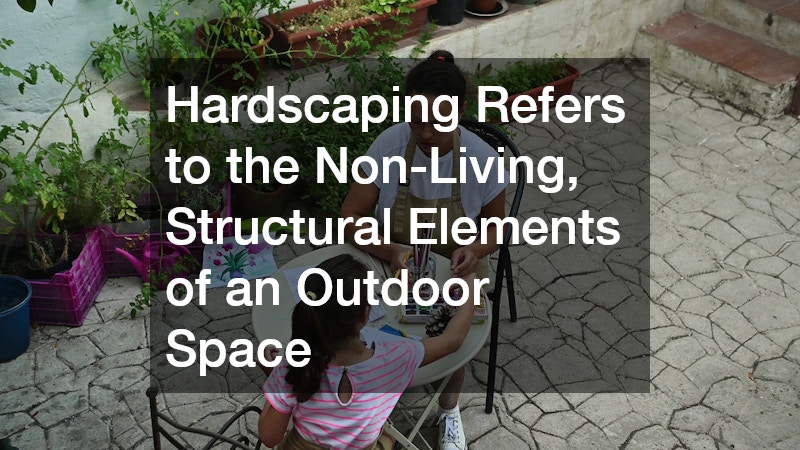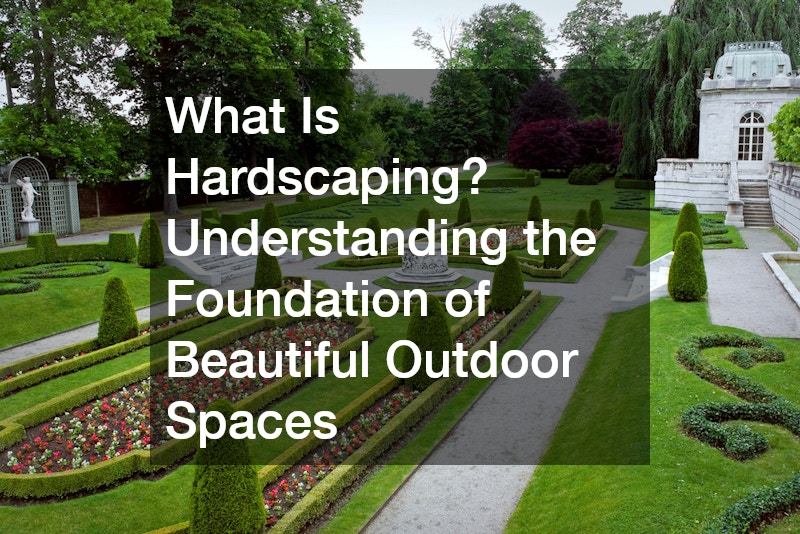When most people think of landscaping, they imagine lush lawns, colorful flowers, and thriving gardens. But just as important as the greenery is the structure that supports and complements it — the hardscape. Hardscaping refers to the non-living, structural elements of an outdoor space, from patios and walkways to retaining walls and fire pits. These features give your landscape shape, functionality, and balance, turning an ordinary yard into a well-designed outdoor living environment.
Understanding what hardscaping entails — and how it enhances both beauty and usability — is the first step toward creating a space that feels complete and inviting. Let’s explore what makes hardscaping such a foundational element of outdoor design and how you can successfully integrate it into your property.
1. What Are the Key Elements of Hardscaping?
a. Definition and Examples of Hardscape Materials
Hardscaping includes all the solid, durable components in your outdoor area. These are the structures that provide form and function — pathways that guide you through the garden, patios that create gathering spaces, and walls that define boundaries or add dimension.
Common hardscape materials include:
-
Natural stone: Timeless and elegant, perfect for patios, steps, or garden walls.
-
Concrete: Versatile and affordable, available in a wide range of finishes, from smooth modern slabs to stamped designs.
-
Brick: A classic choice that adds charm and texture, ideal for walkways or edging.
-
Wood: Great for decks, pergolas, and seating areas, offering warmth and a natural aesthetic.
-
Composite materials: Durable and low-maintenance alternatives to wood, popular for decks and fencing.
Choosing the right material often depends on your climate, design preferences, and intended use. For instance, stone and concrete work best for durability, while wood and composites are excellent for creating a cozy, natural feel.
b. Importance of Design in Hardscaping
Hardscaping is not just about installing stone or concrete — it’s about designing flow and harmony. The best hardscape designs complement the existing landscape and architecture of your home. Thoughtful design considers factors such as shape, layout, scale, and balance to create a cohesive look.
For example, curved pathways can soften a space and lead the eye naturally through a garden, while geometric patios lend a modern, structured feel. The integration of hard and soft elements — such as blending stone borders with lush greenery — helps create visual contrast and texture.
Successful hardscaping ensures that every feature has both purpose and aesthetic value, making your outdoor space functional while maintaining its beauty.
c. Popular Hardscape Features
Today’s homeowners have countless options when it comes to adding hardscape features. Some of the most popular include:
-
Patios and decks: Perfect for dining, lounging, or entertaining.
-
Walkways and pathways: Connect different zones of your yard while enhancing accessibility.
-
Retaining walls: Provide structure, prevent erosion, and can double as seating.
-
Fire pits and outdoor fireplaces: Create warmth and a cozy gathering spot year-round.
-
Outdoor kitchens and bars: Extend your living space and make outdoor dining effortless.
Each element serves a functional purpose while contributing to the visual appeal and comfort of your outdoor environment.
2. How Does Hardscape Benefit Your Property?
a. Increasing Property Value
One of the most significant benefits of hardscaping is its positive impact on property value. Professionally designed and installed hardscape features can dramatically boost curb appeal and make your home more attractive to potential buyers.
A well-built patio or retaining wall adds long-lasting beauty and structure that requires minimal upkeep, making it a valuable selling point. Moreover, outdoor living spaces have become a top priority for modern homeowners, and investing in quality hardscaping can yield a strong return.
b. Enhancing Functionality and Usability
Hardscaping also expands the usable area of your property. Instead of limiting activities to the indoors, you can enjoy dining, relaxing, or entertaining in a well-designed outdoor space.
Features like patios, pathways, and pergolas create distinct zones — for example, a cooking area, a play area, or a quiet retreat. This thoughtful organization transforms your yard into an extension of your home, allowing for year-round enjoyment and improved flow between indoor and outdoor living.
c. Environmental and Maintenance Benefits
Hardscaping can also make your landscape more sustainable and easier to maintain. Properly designed hardscape elements help manage water runoff, prevent soil erosion, and reduce the need for constant mowing or watering. Permeable pavers, for instance, allow rainwater to absorb naturally into the ground, helping replenish groundwater and reduce flooding risks.
Additionally, materials like stone and composite decking require minimal maintenance compared to lawns or flower beds, saving both time and resources in the long run.
3. How to Plan Your Hardscape Project
a. Establishing a Budget
Before you dive into your project, it’s essential to establish a realistic budget. Hardscaping costs can vary significantly depending on materials, labor, and project complexity. For instance, natural stone installations typically cost more than concrete alternatives.
When budgeting, include not just the upfront installation costs but also long-term maintenance. A clear financial plan ensures your project remains on track and prevents costly surprises later.
b. Choosing Materials and Contractors
Selecting the right materials and hiring experienced professionals is key to a successful outcome. Start by considering your climate — freeze-thaw cycles, heat exposure, and rainfall all affect how materials perform over time.
When choosing contractors, look for licensed, insured professionals with proven expertise in hardscape design and installation. Ask for references, review portfolios, and ensure they understand both aesthetics and structural integrity.
c. Phases of Implementation
A typical hardscape project unfolds in stages:
-
Design and planning: Establish goals, select materials, and finalize layouts.
-
Site preparation: Clear the area, address drainage, and lay a solid foundation.
-
Installation: Construct features such as patios, walls, or walkways.
-
Finishing touches: Seal surfaces, add lighting, and integrate landscaping elements.
Each phase plays a vital role in achieving a durable and visually appealing result.
Hardscaping is the foundation of beautiful, functional outdoor spaces. It defines structure, enhances usability, and adds long-term value to any property. Whether it’s a cozy stone patio, a winding garden path, or a sophisticated outdoor kitchen, the right hardscape design transforms an ordinary yard into a personal retreat.
By thoughtfully planning your project, choosing durable materials, and working with skilled professionals, you can create an outdoor space that is not only visually stunning but also built to last. In the end, hardscaping isn’t just about building structures — it’s about creating lasting beauty and balance in your outdoor world.

